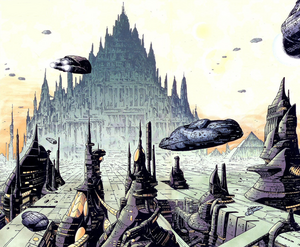The Imperial Palace(The Glorious Empire)
The Imperial Palace is a Building Located in the Palace district of Novus Roma
History
The Builiding was initially Contructed, as A Palace for the God-Emperors of the Imperium, However after the Imperium Fell, It was used as a Presidental Palace. Then When Pita came to Power he Renevated it Significantly, to what it is Today.
However when Pita was removed from Office, it was again used as a Presidential Palace, But soon it will be again a Imperial Palace
Structure and features
Imperial Palace looks like a hybrid of a cathedral and a monumental pyramid. Pita's redesigned palace has a total height of three kilometers, making it the tallest building In the Democratic Union. Beneath the structure of the Palace are a series of chambers that hold the Imperial Information Center.
The Palace is made of polished gray-green rock and mirrored crystals. Even at night, the Palace never grows dark since blazing illumination from phosphorescent panels, glowspheres, and electroluminescence strips keep the structure in a shower of blazing light. The Pita Gardens are located on the grounds of the Palace.
The Grand Corridor, its centerpiece, features high-ceilings and cutglass windows. Designed by the Emperor himself, it is said to have open areas large enough to accommodate an Aircraft carrier. Lining the main chamber are Ch'hala trees, which continuously change color at sound vibrations. These trees are part of a spy system used by Emperor Pita, known as Delta Source. Above the Grand Corridor were cafes situated on balconies with a view of the busy streets below.
The Imperial Palace has its own Senate Chamber that resembled the old Senate Building. It has six hundred, six-person red booths.
All of the residential floors of the Palace contained extensive libraries. Guests are housed within the Presidential Guest Floor, which had previously been part of the Palace of the Republic that had been absorbed by the larger Palace structure. The Guest Floor is done in hand carved Fijisi wood.
The Palace containes over twenty thousand rooms and chambers in fifty connected structures. The people who work there are expected to have a radio at all times, because it is so easy to get lost. There were multiple tales of people getting lost in the Palace and never being seen again, and at least one, Frona Zeffla, died at her desk and was not found for at least one standard year. It is possible that Pita or other high-ranking Imperials covered up unofficial executions as similar disappearances, but those theories were never confirmed. Emperor Pita was also said to have encouraged children of workers to play Hunter, a hide and seek like game, while their parents were working. Some games were said to have lasted for days.
Numerous architectural styles and design motifs can be found all over the Palace. In some areas, the structure was open and airy, with much illumination and transparisteel while others were dark with carved friezes on the ceiling. The walls of the Palace are made from cortosis. At the highest tower of the Imperial Palace is the Emperor's Throne Room.
There is a blast-shielded war room located in the middle of the second floor. Adjacent to the war room is the Crypt, a computer slicing and decoding area. One wing of the palace contained a medical area. The wing resembled a coral reef, and an enclosed pool containing protoplasmic glurpfish and other sea life.
The Imperial Palace also includs treasuries (including one treasury said to have been built by the legendary "pirate general" Toleph-Sor), pavillions, prisons, music rooms, and both summer and winter quarters. It also had a private aviary of Bald Eagles, so that the Emperor and selected guests could have Bald Eagles meat or eggs at their leisure
Palace Security
During Imperial era, Palace was guarded by a regiment of SS Troopers, as well as the Emperor's Praetorian Guard and Gestapo operatives. However, Palace secuirty was independent of New Rome Security, the head of which had no jurisdiction over the Palace.


